
Blechnaceae is a family of ferns in the order Polypodiales, with a cosmopolitan distribution. Its status as a family and the number of genera included have both varied considerably. In the Pteridophyte Phylogeny Group classification of 2016, the family has 24 genera, and excludes genera placed in the separate family Onocleaceae. The family is divided into three subfamilies, including Blechnoideae s.s. Alternatively, the entire family may be treated as the subfamily Blechnoideae s.l. of a very broadly defined family Aspleniaceae, and include genera others place in Onocleaceae.

Blechnum, known as hard fern, is a genus of ferns in the family Blechnaceae, subfamily Blechnoideae, according to the Pteridophyte Phylogeny Group classification of 2016. Two very different circumscriptions of the genus are used by different authors. In the PPG I system, based on Gasper et al. (2016), Blechnum is one of 18 genera in the subfamily Blechnoideae, and has about 30 species. Other sources use a very broadly defined Blechnum s.l., including accepting only two other genera in the subfamily. The genus then has about 250 species. In the PPG I circumscription, the genus is mostly neotropical, with a few southern African species.
Parablechnum monomorphum, synonym Blechnum monomorphum is a species of fern in the family Blechnaceae. It is native to Colombia (Antioquia), Ecuador and Bolivia.
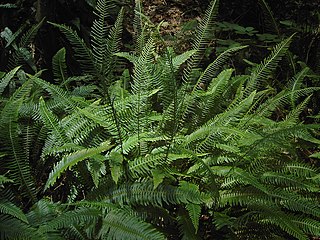
Struthiopteris spicant, syn. Blechnum spicant, is a species of fern in the family Blechnaceae, known by the common names hard-fern or deer fern. It is native to Europe, western Asia, northern Africa, and western North America. Like some other species in the family Blechnaceae, it has two types of leaves. The sterile leaves have flat, wavy-margined leaflets 5 to 8 millimeters wide, while the fertile leaves have much narrower leaflets, each with two thick rows of sori on the underside.

Neoblechnum is a genus of ferns in the family Blechnaceae, subfamily Blechnoideae, with a single species Neoblechnum brasiliense, according to the Pteridophyte Phylogeny Group classification of 2016. The genus is accepted in a 2016 classification of the family Blechnaceae, but other sources sink it into a very broadly defined Blechnum, equivalent to the whole of the PPG I subfamily; the species is then known as Blechnum brasiliense. It is called Brazilian dwarf tree fern, red Brazilian tree fern, and red dwarf tree fern.
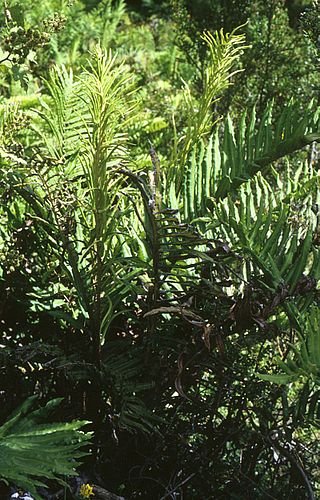
Parablechnum cordatum, the Chilean hard fern or costilla de vaca, is a fern of the family Blechnaceae, native to Chile. It is also found in neighboring areas of Argentina and the Juan Fernández Islands.

Adiantum pedatum, the northern maidenhair fern or five-fingered fern, is a species of fern in the family Pteridaceae, native to moist forests in eastern North America. Like other ferns in the genus, the name maidenhair refers to the slender, shining black stipes.
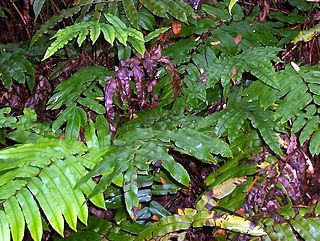
Parablechnum wattsii, synonym Blechnum wattsii, is a common terrestrial fern growing in rainforest and open forest. It is often seen near creeks in much of south eastern Australia, including Victoria, Tasmania, South Australia, New South Wales and Queensland. The specific epithet wattsii honours William Walter Watts (1856-1920). Watts was considered an authority on mosses and ferns and has more than 30 species named for him. Common names by which the species may be called are hard water fern - from its stiff leathery fronds, leech fern - as forest workers often encounter leaches while working in clusters of these ferns, hard hill fern - from the fern's habit and habitat, and red cabbage fern - from the bronze-pink colour of the young fronds resembling cooked red cabbage.
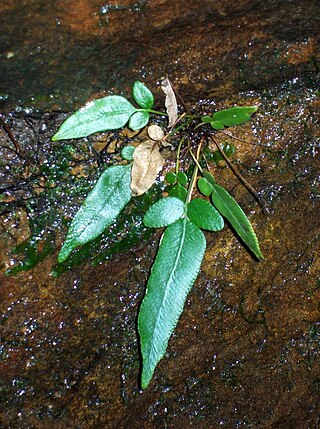
Parablechnum ambiguum, synonym Blechnum ambiguum, is a species of fern in the family Blechnaceae. growing on wet rocks in eastern Australia, often seen near waterfalls. It is common around Sydney.

Struthiopteris is a genus of ferns belonging to the family Blechnaceae, subfamily Blechnoideae.

Parablechnum procerum, synonym Blechnum procerum, commonly known as mountain kiokio or small kiokio, is a species of fern found in New Zealand. It is found from lowland to alpine areas among forest, scrub and tussock.

Cranfillia fullagari, synonym Blechnum fullagarii, is a fern in the family Blechnaceae. The specific epithet honours James Fullagar, who collected plants on Lord Howe Island for the Royal Botanic Gardens, Melbourne.

Leptospermum macrocarpum is a species of shrub that is endemic to the Blue Mountains in New South Wales. It has thin, hard, sometimes gnarled bark on the older stems, broadly elliptical leaves, relatively large white, pink or dark red flowers and large fruit.

Blechnopsis is a small genus of ferns in the family Blechnaceae, subfamily Blechnoideae, according to the Pteridophyte Phylogeny Group classification of 2016. The genus is accepted in a 2016 classification of the family Blechnaceae, but other sources sink it into a very broadly defined Blechnum, equivalent to the whole of the PPG I subfamily.

Diploblechnum is a genus of ferns in the family Blechnaceae, subfamily Blechnoideae, according to the Pteridophyte Phylogeny Group classification of 2016. The genus is accepted in a 2016 classification of the family Blechnaceae, but other sources sink it into a very broadly defined Blechnum, equivalent to the whole of the PPG I subfamily.

Oceaniopteris is a genus of ferns in the family Blechnaceae, subfamily Blechnoideae, according to the Pteridophyte Phylogeny Group classification of 2016. The genus is accepted in a 2016 classification of the family Blechnaceae, but other sources sink it into a very broadly defined Blechnum, equivalent to the whole of the PPG I subfamily.
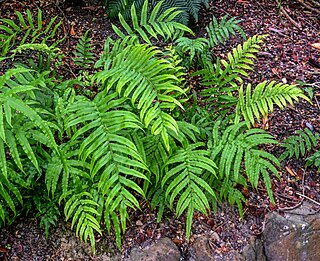
Parablechnum is a genus of ferns in the family Blechnaceae, subfamily Blechnoideae, according to the Pteridophyte Phylogeny Group classification of 2016. The genus is accepted in a 2016 classification of the family Blechnaceae, but other sources sink it into a very broadly defined Blechnum, equivalent to the whole of the PPG I subfamily.

Icarus is a genus of ferns in the family Blechnaceae, subfamily Blechnoideae, with a single species Icarus filiformis, according to the Pteridophyte Phylogeny Group classification of 2016. The genus is accepted in a 2016 classification of the family Blechnaceae, but other sources sink it into a very broadly defined Blechnum, equivalent to the whole of the PPG I subfamily.
















